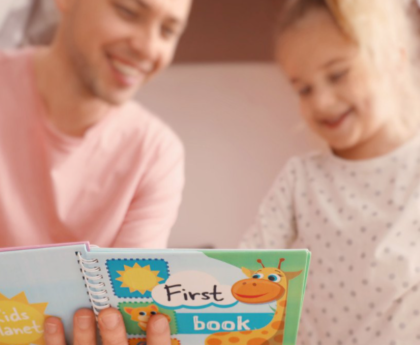The ability to decode words, read them fluently, and understand their meaning is the goal of successful reading. To do this, children need to develop reading comprehension skills. According to the National Reading Panel, The five pillars of learning to read are phonemic awareness, phonics, fluency, vocabulary, and comprehension. All five components are important, but the first four are foundational skills that lead to the top of the pyramid—or final goal—of comprehension.
What Is Reading Comprehension and Why Is It Important?
Simply put, reading comprehension means understanding what is being read. It involves reading actively and thinking about the text. Students who can decode and read words fluently but don’t understand what they’re reading are not fully engaging with the text. They aren’t reading with purpose. To fully engage with a text and understand it, students need to utilize a variety of comprehension strategies. This is how good readers monitor what they’re reading to construct meaning.
How to Improve Reading Comprehension
Knowing how to read for meaning is easier said than done. For advanced readers, comprehending what they read seems like a natural process, but it is actually quite complex. A lot goes into understanding a text. Comprehension involves having a variety of stored schemas, or background knowledge and prior experiences, that are easily activated during reading. The more schemas someone has, the more they are able to connect to and understand what they’re reading. Comprehension also involves having a strong vocabulary. Knowing the meaning of a large variety of words helps with understanding them in context. In addition, those with strong comprehension skills have a toolbox of familiar strategies at the ready, an understanding of a variety of text structures, and a sustained ability to attend to the text and think about what is being read.
For a struggling reader, their focus during reading is often on decoding, or figuring out the words. Readers who aren’t fluent and are thinking about the words individually have a harder time thinking about the meaning of the words and the overall meaning of the passage. And even those who are fluent readers can have difficulty understanding what they read if they have a limited vocabulary, lack schemas or strategies, or can’t attend to their reading.
In other words, comprehension in reading is a process that needs continued reinforcement and practice—even for advanced readers. To help your child with their reading and comprehension skills, here are a few tips and strategies:
Read for Fun: Find books and topics that interest your child, making reading more enjoyable for them. The more engaged your child is in what they’re reading, the better they will be able to attend to it, which helps their comprehension.
Read Aloud: Reading aloud allows your child to hear the words as well as see them, which helps them better process what they’re reading. It also encourages a child to read slower and better focus on what they’re reading.
Read at the Appropriate Level to Build Fluency: To fully comprehend, a child should be reading at their reading level. Reading should flow at a similar rate to how we talk. Books that are too hard will be a struggle to read fluently, and this will slow down the pace and limit comprehension. Books that are too easy will not provide enough challenge to improve comprehension skills. When a book is read to a child, it can be a level or two above the child’s reading level because most kids have listening comprehension that is higher than their reading ability. If your child struggles to decode words, then comprehension can suffer because their mental energy is being used to figure out the words rather than extract meaning from them. Finding a program that helps build foundational reading skills will help strengthen your child’s fluency so they can focus more on reading for meaning.
Build Vocabulary and Schemas: Help your child build their word knowledge and background knowledge by engaging them in conversation. Give them new words to describe things they see, feel, and discover. Help them make associations to new words by connecting them to what they already know. Read aloud with your child and talk about what you’re reading. Provide them with enrichment experiences to expand their awareness. Help them make connections between what they are reading and the world around them. Research suggests that one of the reasons some learners struggle with math and science (and even social studies and other areas) later in learning is because they haven’t been exposed to the vocabulary used in those subjects when they were younger, so those subjects become overwhelmingly confusing when they’re trying to read and understand them. Exposing kids to nonfiction texts and enrichment experiences in a variety of subject areas helps build their oral vocabulary in those topics.
Stop and Think, Summarize, and Ask Questions: Have your child tell you in their own words about a story or passage that they read. Ask them comprehension questions that focus on the story elements of a fiction story or the main idea and important details of a nonfiction passage. Encourage them to generate their own questions as they read and to answer these questions as they continue reading. Have your child stop and think after a paragraph, page, or passage of text. For fiction text, summarize using Who, What, and Why: Who is this part of the story about? What are they doing? And why are they doing that (How does it affect the story)? For nonfiction text, summarize Main Idea and Key Details by asking What is this part mostly about? What key details helped you figure that out? What did you learn or find interesting?
Monitor and Reread: Along with the previous suggestion of summarizing and asking questions, comprehension monitoring is a way for your child to check in with themselves to gauge whether they’re paying attention and understanding what they read. They can do this by asking themselves What did I just read? Did it make sense? At this point, your child may decide to reread a page or paragraph or to try a different strategy to help with understanding.
Practice Visualizing: Mentally picturing what is happening or what information is being presented helps with attending to the text. It requires active thinking during reading. For a child that doesn’t have the necessary schemas to visualize what they’re reading, you can help by showing them pictures, looking up information, or connecting to something they already know. During reading, encourage your child to create pictures in their head. Or, if it helps them focus, you can have them draw what they’re picturing as they read or listen to the text. Stop periodically during reading and have your child describe what they’re visualizing. How does it relate to what is in the text? What can you add to their image to give them a clearer picture of what was read?
Use Multiple Comprehension Strategies: There are many great resources online or in workbooks that can be used to help improve reading comprehension through the use of explicit reading strategies. In addition to the ones already mentioned above, other key strategies include: Predicting, Making Inferences/Drawing Conclusions, Using Context Clues, Making Connections, Comparing and Contrasting, Sequencing, Recognizing Cause and Effect, Evaluating, and Synthesizing. The use of graphic organizers can help with practicing reading strategies. Reading.com incorporates reading comprehension activities for early readers to complete together with their parent to begin building literacy skills. Raising Readers is designed to offer parents simple and explicit instruction to easily teach their child to read, lesson by lesson.
Resources for Improving Reading Comprehension Strategies
The following sites offer free printables or online English reading practice for grades K–12:
Understood.org, Daily Teaching Tools , and Teachnology – downloadable graphic organizers
Into the Book – resources for improving comprehension using reading strategies
ReadWorks.org – a searchable library of content, curricular supports, and digital tools for improving reading comprehension
ReadWriteThink – a large collection of literacy resources put together by the National Council of Teachers of English, searchable by grade level, learning objectives, or topic
K5 Learning and Teachnology, Easy Teacher Worksheets, K12 Reader, and Education.com – comprehension worksheets and passages organized by grade, skill, strategy or topic
ReadTheory, English For Everyone, EReading Worksheets and SoftSchools – comprehension worksheets or quizzes available to print or complete online
Lit2Go – stories and poems in audiobook or pdf formats with related reading strategies
East of the Web – collection of short stories with questions and activities
Super Teacher Worksheets – comprehension, language arts, and phonics worksheets, articles, passages, poems, mini books, and readers’ theater scripts
The Teacher’s Guide – worksheets for informational text passages, literature, and poetry, as well as story elements and nonfiction text resources
Mr. Nussbaum Learning + Fun – comprehension exercises with printables and instructional videos
Worksheet Library and English Worksheets Land – skills-based and leveled passage comprehension worksheets and resources
ReadingResource.net – printable worksheets to accompany Starfall’s easy readers and interactive books, as well as other reading resources
ItsyBitsyFun.com – worksheets for young readers (K–1)
ISL Collective and UsingEnglish.com – ESL reading comprehension worksheets RHL School – comprehension worksheets for original stories, poems, essays, and articles





